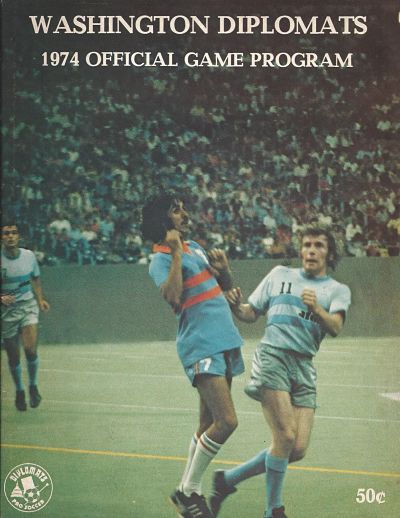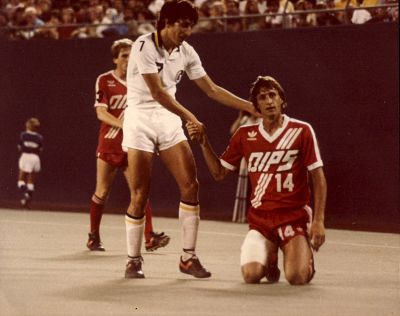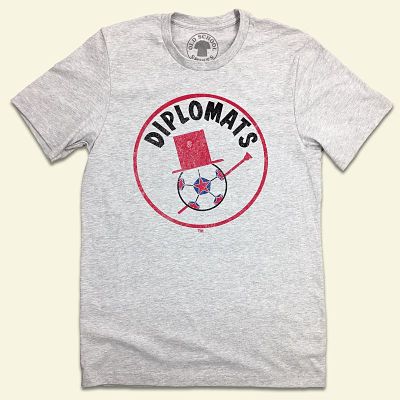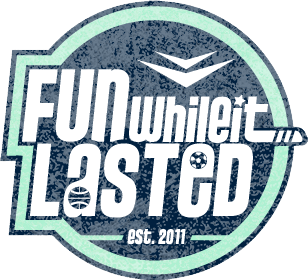North American Soccer League (1974-1981)
Tombstone
Born: January 21, 1974 – NASL expansion franchise1ASSOCIATED PRESS. “Washington gets NASL franchise”. The Sun (Vancouver, BC). January 22, 1974
Folded: December 1980
Re-Born: February 27, 1981 – The Detroit Express relocate to Washington, D.C.21981 Washington Diplomats Media Guide
Folded Again: September 1981
First Game: May 4, 1974 (L 5-1 vs. Philadelphia Atoms)
Last Game: August 18, 1981 (L 1-0 @ Montreal Manic)
Soccer Bowl Championships: None
Stadia
Outdoor:
1974-1975: RFK Stadium (55,000)31978 North American Soccer League Guide
Opened: 1961
Closed: 2017
1975-1976: W.T. Woodson High School
1977-1981: RFK Stadium (55,000)
Indoor (Exhibitions):
1978: Starplex DC Armory
Opened: 1941
Marketing
Team Colors:
- 1975: Red, White & Blue41975 North American Soccer League Media Guide
- 1978: Red, White & Black51978 North American Soccer League Guide
- 1981: Red, White & Blue61981 Washington Diplomats Media Guide
Cheerleaders: The Sidekicks
Mascot: The Diplomaniac (unspecified furry creature)
Television:
- 1977-1981: WTTG (Channel 5 – selected games)
Television Broadcasters:
- 1981: Jim Forney (play-by-play) and Jimmy Hill (color)
Radio:
- 1980-1981: WWDC (1260 AM)
Radio Broadcasters:
- 1980-1981: Mike Zimet (play-by-play)
Ownership
Owners:
- 1974: Nick Mangione, Jim Karvellas, Mike Finci, et. al.
- 1975-1978: San Juan Racing, Inc. (Steve Danzansky, et al.)
- 1979-1980: Gulf & Western/Madison Square Garden Corp. (Sonny Werblin & Steve Danzansky)
- 1981: Jimmy Hill, Duncan Hill, Gary Lemmen, et al.
Attendance
Tap (mobile) or mouse over chart for figures. Tilting your mobile device may offer better viewing.
Source: Kenn.com Attendance Project
Our Favorite Stuff
Washington Diplomats
NASL Logo T-Shirt
For a moment at the end of the ’70’s it seemed like the Dips had aspirations to become “Cosmos South”. A glamorous super club with rich corporate owners that attracted international superstars and packed NFL stadiums. Instead they became something closer to “Aztecs East” , but they had a lot of fun doing it, highlighted by the arrival of Johan Cruyff in the spring of 1980.
This Dips tee design is available today in sizes Small through 4XL at Old School Shirts!
When you make a purchase through an affiliate link like this one, Fun While It Lasted earns a commission at no additional cost to you. Thanks for your support!
Background
The Washington Diplomats were the third attempt to establish pro soccer – and a North American Soccer League franchise – in the nation’s capital. The Dips followed the defunct Whips (1967-1968) and the Darts (1967-1971).
Club founders Nick Mangione and Mike Finci ponied up $75,000 to buy their NASL expansion franchise in January 1974. The Diplomats hired former Manchester United star and Munich air disaster survivor Dennis Viollet to coach the team.

Early Years
The Dips struggled to establish an identity in their early years. The team was mediocre during the Viollet era (1973-1977) and qualified for the postseason only once. Ownership changed hands in 1975, with the Danzansky family buying out Mangione and his partners for $650,000.
The club bounced back and forth between RFK Stadium and a high school football stadium in Fairfax, Virginia from 1974 to 1976. RFK conveyed big-city, Major League status. W.T. Woodson High School was economical and more convenient for the Dips’ white flight core audience. But the Fairfax games also marked the Dips as a minor league experience.
The Diplomats’ glory years came during a brief period at the end of the 1970’s. The club hired John Carbray as General Manager in October 1976. Carbray, a veteran minor league baseball exec, first brought his innovative promotions to soccer in 1976 with the NASL’s San Jose Earthquakes. Carbray persuaded Dips’ ownership to commit to RFK Stadium once and for all. The NASL was never a league to worry much about FIFA conventions. Carbray embraced the league’s permissiveness, introducing multi-colored penalty areas and goal boxes at RFK. He also hired former New York Cosmos manager Gordon Bradley to replace Viollet as the club’s Head Coach in 1978.
Announced attendance rose from 5,963 per game in Fairfax in 1976 to 13,037 at RFK in 1977 during Carbray’s first season in charge. The team had a major on-field improvement in form in 1978 under Gordon Bradley. But attendance fell back to 10,783 and the team remained deeply in the red.
Madison Square Garden Era
A lifeline arrived in October 1978 when Madison Square Garden Corporation, a subsidiary of the publicly traded conglomerate Gulf & Western, purchased the team. Madison Square Garden owned the NBA’s New York Knicks and the NHL’s New York Rangers. MSG Chief Executive Officer Sonny Werblin was the man who built the New York Jets and signed Joe Namath, setting in motion the AFL’s infamous upset of the NFL champion Baltimore Colts in Super Bowl III. With Gulf & Western’s resources behind the team, it suddenly seemed plausible that the Diplomats could take on the Time Warner-owned New York Cosmos as an international super club.
“Sonny and his crew are out to spend it all,” Atlanta Chiefs Director of Operations Terry Hanson predicted to Alex Yannis of The New York Times in December 1978. “I hear they are going to crank the whole thing wide open, spend all the money they have for players … I hear they already call them the Cosmos of the South.”

Star Search
After Madison Square Garden’s takeover, the Diplomats negotiated for Argentine World Cup captain Daniel Passarella and courted English captain and 1978 European Footballer-of-the-Year Kevin Keegan. Both bids failed.
Then, in February 1980, the Diplomats got their superstar. Sonny Werblin laid down a big marker on the Diplomats and the NASL by paying a jaw-dropping (at the time) $1 million transfer fee to the NASL’s Los Angeles Aztecs for superstar Dutch midfielder Johan Cruyff, the league’s reigning MVP. Cruyff and the Aztecs ended Washington’s 1979 season in the first round of the NASL playoffs. Now Cruyff was a Diplomat and the team inked him to a 3-year, $1.5 million contract extension.
Werblin also shelled out to acquire Cruyff’s Dutch international teammate Wim Jansen and 24-year old Spanish attacking midfielder Juan Jose Lozano, the latter being a rare example of the NASL importing an up-and-coming foreign star rather than a graybeard taking a victory lap. Lozano cost a reported $750,000 but would make just 10 appearances for the Dips before leaving the NASL and returning to Europe.7Baker, Chris. “Diplomats Are in Right Place”. The Times (Los Angeles, CA). August 29, 1980
All In
On and off the field, the Dips went all in on the 1980 season. If the team’s big bet on Cruyff, Lozano, Jansen and other could pay off competitively, a tantalizing prospect awaited at season’s end. The NASL selected the Diplomats and RFK Stadium to play host to the Soccer Bowl championship game on September 21st, 1980.
The team made its first appearance in the capital on April 13, 1980 with a 3-1 victory over the Philadelphia Fury. The crowd of 24,203 was the largest opening day Dips crowd in club history, but also showed that the club still had to far to go to challenge the exalted status of the Cosmos. On the same day, the Cosmos drew 51,225 for their own home opener.
On June 1st, 1980, the Dips went up against the Cosmos at RFK before a franchise record crowd of 53,351. The nationally televised match was a thriller, with the Dips taking a 1-0 first half lead on a Bob Iarusci penalty, before relinquishing the lead on a Giorgio Chinaglia header in the second half. New York sealed the victory with a Vladislav Bogicevic goal in the NASL’s unconventional tiebreaker shootout.
Ultimately, despite the massive investment in players and publicity, the Dips’ 1980 season was a virtual replay of the pre-Cruyff 1979 campaign. The team finished 17-15, down from 19-11 a year earlier. More importantly, they finished 2nd place to the Cosmos in the division for the third season in a row. And, like in 1979, they suffered a disappointing first round playoff exit at the hands of the Los Angeles Aztecs.
At the box office, Diplomats attendance surged 62% to an franchise best 19,205 per game. Though the team would not make it to Soccer Bowl ’80, a massive crowd of 50,768 turned out at RFK regardless to watch the Cosmos claim their third NASL title in four years with a 3-0 rout of the Fort Lauderdale Strikers.

Collapse
Still, all was not well. By October 1980, Madison Square Garden Corp. was openly grumbling about the state of the league and its investment. On October 27th, the team embarked on a 10-game tour of the Far East, just as things were falling apart back in the nation’s capital.
On November 24th, 1980 the NASL announced that the Diplomats had “voluntarily terminated” their membership in the league. Madison Square Garden had lost an estimated $5 million on the club over two years of operations.8UNITED PRESS INTERNATIONAL. “NASL’s Washington Diplomats, Two Other Franchises Fold”. The Times Argus (Barre, VT). November 25, 1980 Weirdly, the Diplomats players were still in Tokyo that day, playing the final match of their Asian tour against the Japanese National Team.
Double Dipping
Three months after the original Diplomats gave up the ghost, the team (or at least its logo) got an unlikely reprieve. English football broadcaster Jimmy Hill owned the NASL’s Detroit Express franchise. The three-year old club was beset by financial problems and internecine warfare among its investors. On February 27, 1981, just 29 days before the 1981 NASL season opener, the league approved the relocation of the Express to Washington D.C., where the club would reclaim the Dips name and logo and play out of RFK.
Dips II ended up being a sad coda to the original club’s tenure. Jimmy Hill and has son Duncan had nothing resembling the resources of Gulf & Western. With little time or money to promote the team, the new Dips were merely mediocre. Even the midseason return of a diminished and hobbled Johan Cruyff – now earning $175,000 rather than the $500,000 he would have pocketed from year two of his original Dips contract – failed to spark the team on the field or at the box office. The new Dips finished 15-17, missed the playoffs, and folded in September 1981, barely six months after arriving in town.
The North American Soccer League closed its down in 1985. In 1987, yet another edition of the Dips took up residence at RFK Stadium, playing in the low-budget American Soccer League until 1990.
Washington Diplomats Shop
Editor's Pick
Rock n' Roll Soccer
The Short Life and Fast Times of the North American Soccer League
by Ian Plenderleith
The North American Soccer League – at its peak in the late 1970s – presented soccer as performance, played by men with a bent for flair, hair and glamour. More than just Pelé and the New York Cosmos, it lured the biggest names of the world game like Johan Cruyff, Franz Beckenbauer, Eusebio, Gerd Müller and George Best to play the sport as it was meant to be played-without inhibition, to please the fans.
The first complete look at the ambitious, star-studded NASL, Rock ‘n’ Roll Soccer reveals how this precursor to modern soccer laid the foundations for the sport’s tremendous popularity in America today.
When you make a purchase through an affiliate link like this one, Fun While It Lasted earns a commission at no additional cost to you. Thanks for your support!
Washington Diplomats Video
Dips host the Cosmos at RFK on April 8, 1979. Check out the Dips’ distinctive penalty area markings.
In Memoriam
Owner Sonny Werblin (Dips ’79-’80) died of a heart attack on November 21, 1991 at the age of 81. New York Times obituary.
Forward Bobby Stokes (Dips ’77-’80) died of bronchial pneumonia on May 30, 1995 at 44 years of age.
Manager Dennis Viollet (Dips ’74-’77) passed away after a two-year battle with brain cancer on March 6, 1999 at age 65.
Manager Gordon Bradley (Dips ’78-’80) passed on April 29, 2008 after fighting Alzheimer’s Disease. He was 74. New York Times obituary.
Midfielder John Kerr, Sr. (Dips ’76-’77) passed away from heart disease on June 19, 2011 at the age of 67. Washington Post obituary.
Midfielder Johan Cruyff died of cancer on March 24, 2016. The Flying Dutchman was 68 years old. New York Times obituary.
Downloads
8-6-1977 Washington Diplomats vs. New York Cosmos Game Notes
8-6-1977 Washington Diplomats vs New York Cosmos Game Notes
1977 Washington Diplomats Ticket Brochure
1977 Washington Diplomats Media Guide Additions & Deletions
5-27-1980 Washington Diplomats vs. New York Cosmos Match Preview Press Advisory
6-1-1980 Washington Diplomats vs. New York Cosmos Game Notes
Soccer Bowl ’80 Ticket Order Form
1980 Arthur Treacher’s Soccer Teacher Booklet
8-12-1981 Washington Diplomats vs. New York Cosmos Game Notes
Links
###





One Response